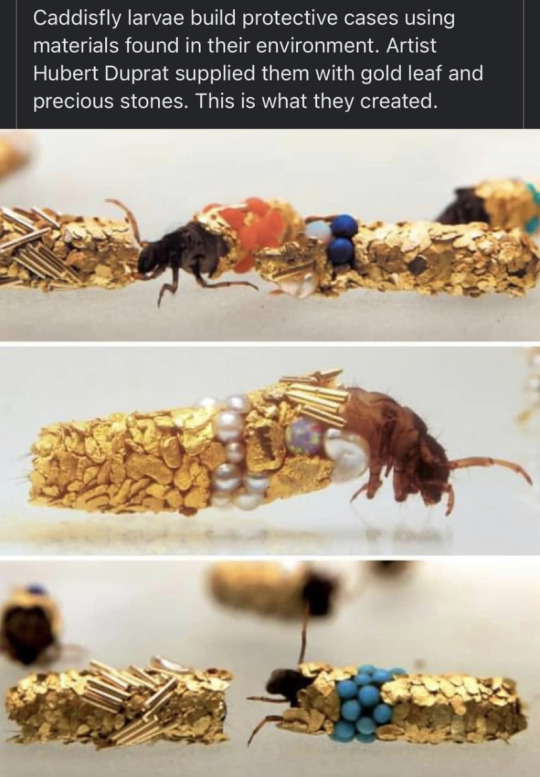#caddisfly
Photo
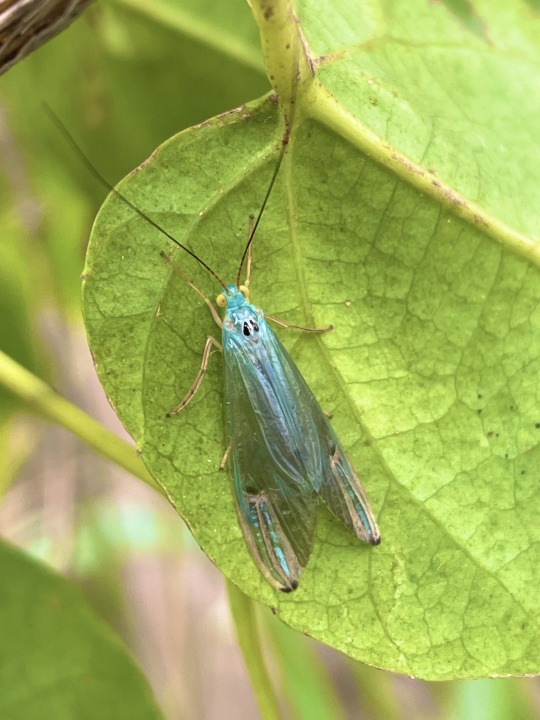
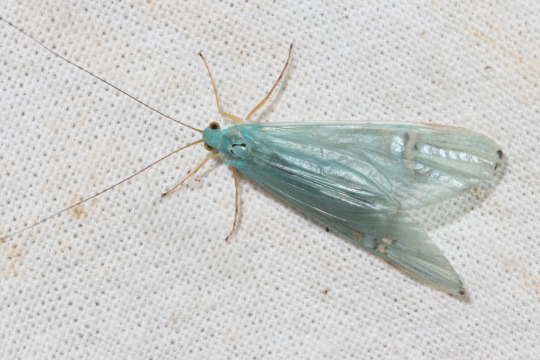
Blue net-spinning caddisfly, Polymorphanisus elisabethae, Hydropsychidae, Trichoptera
Found in Sub-Saharan Africa
Photo 1 by stefaneakame and 2 by thijsvalkenburg
#animals#curators on tumblr#insects#bugs#caddisfly#net spinning caddisfly#blue net spinning caddisfly#trichoptera#one nice bug
1K notes
·
View notes
Text
I was so happy to see one of my favorite examples of visual mimicry in Costa Rica! take a look at this Petrophila moth and a Nectopsyche caddisfly. notice anything familiar about the pattern they seem to share?


it’s the front view of a jumping spider! black round eyes in rows, and stripes for legs with gaps between them. the resemblance, especially seeing the mimics at actual size in person, is striking. both moth and caddisfly have a reflective white patch of scales around the eyes, making them seem reflective and alert.
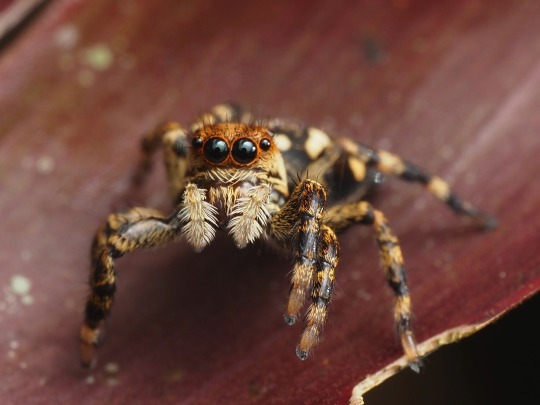
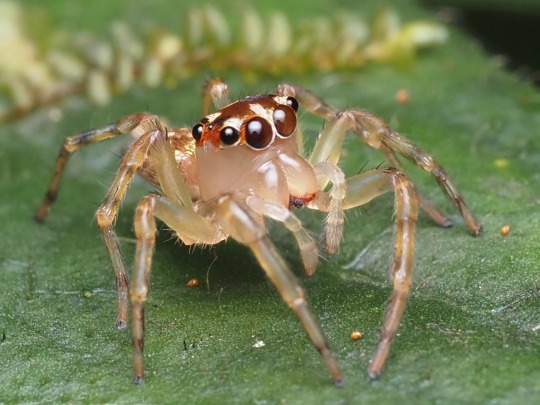
jumpers are active visual predators, a threat to small insects but also to one another, and have good facial recognition skills for members of their taxonomic family who might be rivals or predators. it’s thought that a jumping spider, viewing a mimic, might be scared off or even consider it a rival and start a territorial display, giving the mimic time to flee.

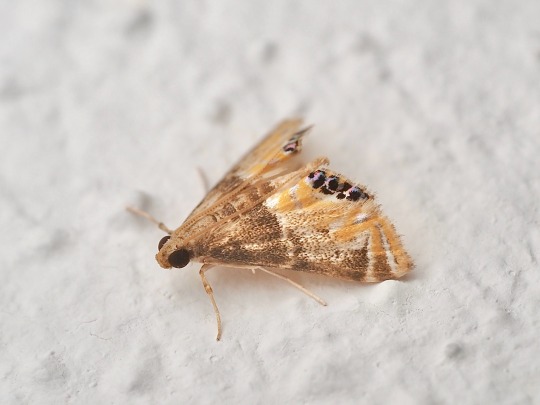

many Petrophila and their relatives in the subfamily Acentropinae have the jumping spider patterns, and I saw a few species with varying degrees of spideriness. there’s a surprising amount of other arthropods that mimic jumpers, too, from planthoppers to cockroaches and even other jumping spiders with false eyes.
1K notes
·
View notes
Text
Y’all know that in general I prefer the Squishy animals over the Crunchy, but one insect in particular is very enchanting to me and that is the caddisfly. Larval caddisflies build themselves little houses out of whatever is lying around and spend their whole juvenile lives in it! They even pupate inside their little house! And the type of house depends on the species! Some of them build little log cabins:

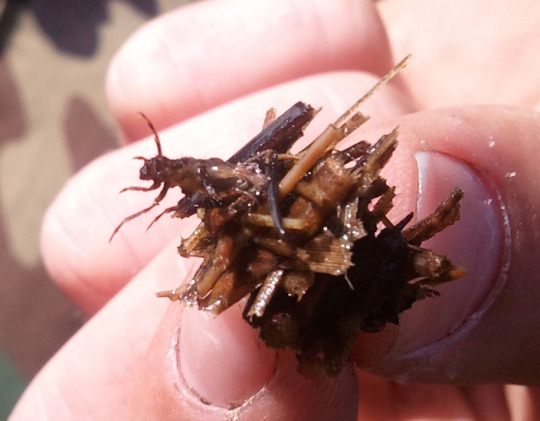
Some build long cases out of twigs and leaves
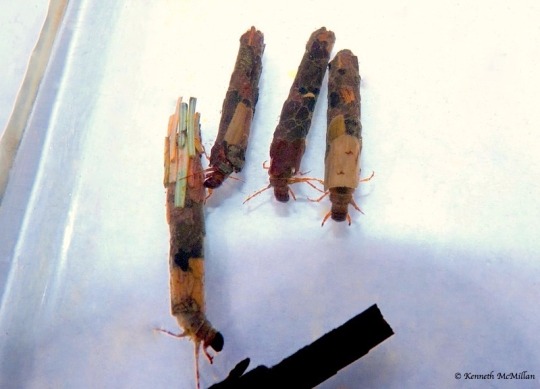
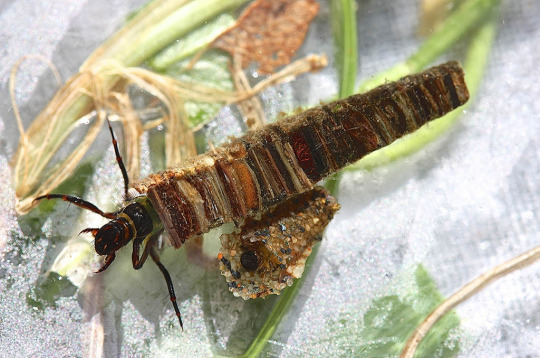
Others use pebbles
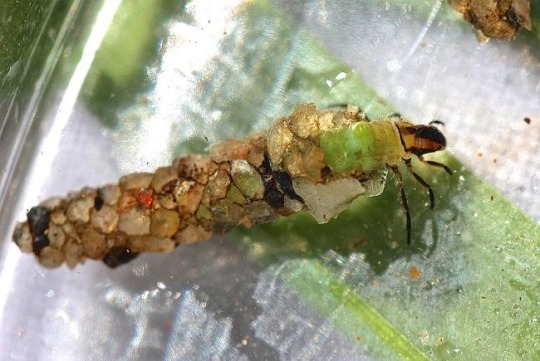
Look at this guy! He’s decorated with snail shells! What a snazzy little dude!

And GUESS WHAT you can offer them pretty shiny building materials and they’ll make cases out of that too. And after they pupate they emerge as a flying adult and take off so you can use the empty case as jewelry.
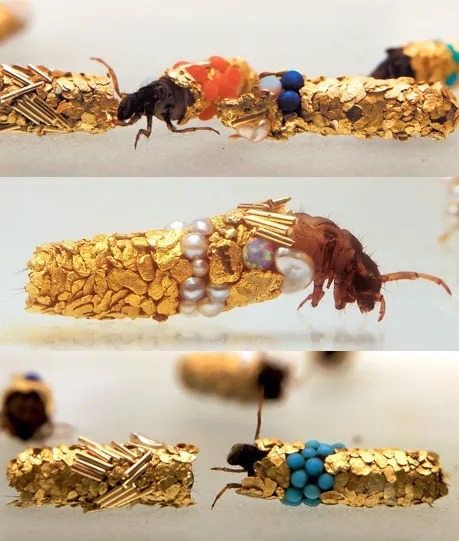
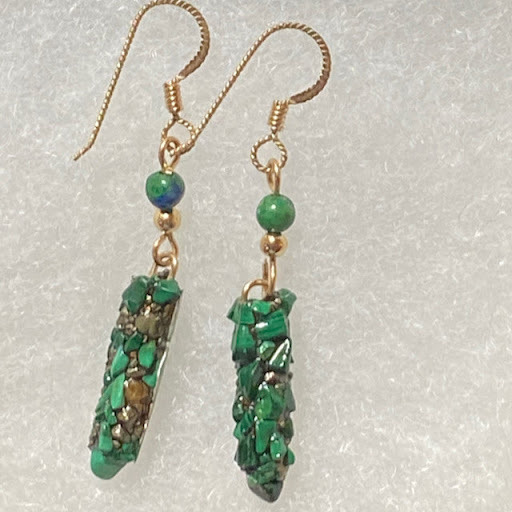
And look at their little faces.
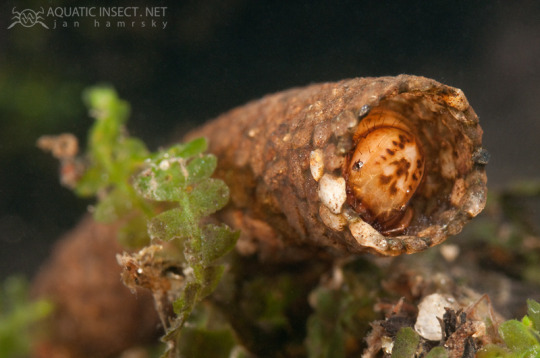
“Away from my dwelling please”
226 notes
·
View notes
Text

Greena and Black Net-spinning Caddisfly (Macronema argentilineatum), family Hydropsychidae, order Trichoptera, Ecuador
Though it looks very much like small colorful moth, this creature is in a totally different group of animals... the caddisflies.
Find out more: Caddisfly - Wikipedia
photograph by Eerika Schulz
136 notes
·
View notes
Text
Wet Beast Wednesday: aquatic insect larvae
This Wet Beast Wednesday is going to be different than usual. Instead of an in-depth overview of a specific species or group of species, I'm going to give a general overview of aquatic insect larvae as a whole and then showcase some groups of insects. I'm going to focus on insects that have an aquatic larval stage and terrestrial adult stage, saving adult aquatic insects for another post.
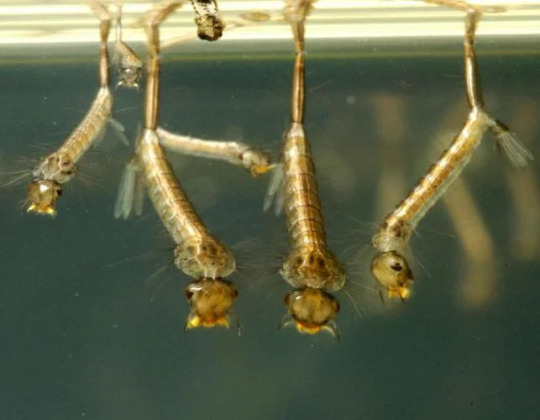
(Image ID: a group of mosquito larvae. They are yellowish bugs with long, slender bodies, no visible limbs, small heads, and feathery appendages from their rear ends. From the back of the abdomen, a snorkel-like appeadage attaches to the surface of the water, using surface tension to allow the larvae to hang from the surface. End ID)
Insects are basically the most successful group of animals in the history of life on Earth and have adapted to live in just about every terrestrial habitat. It should not be much of a surprise than that they have also moved into the water. More specifically, fresh water as almost all aquatic insects inhabit fresh or maybe brackish water. Only the water strider genus Halobates are truly marine. Some species of insect are aquatic for their entire lives, some are primarily terrestrial but able to swim, and some are aquatic only for their larval stage of life. These aquatic larvae species are generally agreed to have evolved from fully terrestrial ancestors. The adaptation of partially returning to the water has evolved independently many times in many different clades of insect and so different species use different strategies and adaptations. It is possible that aquatic larvae evolved in response to high competition for resources on land. If multiple species are competing over the same resources during their larval stages but one of those species manages to adapt to a whole new environment, that species will now have abundant access to resources the other species are unable to get to. Because of the very different lifestyles required for aquatic and terrestrial animals, aquatic larvae often look very different than their adult forms.
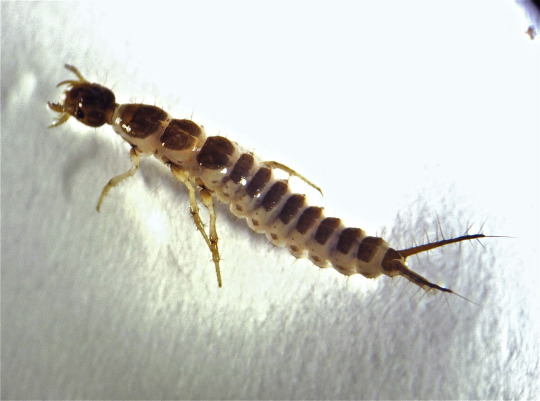
(Image: an aquatic beetle larva. It looks nothing like an adult beetle, instead being a long, slender insect with no wings, multiple body segments, and two hairy appendages at the base of the abdomen. End ID)
Aquatic larvae serve important roles in their ecosystems. Many are herbivores or detritivores that consume algae and bits of biological material, helping recycle nutrients and clean the water. Some are predators that hunt smaller invertebrates or plankton. Importantly, aquatic insect larvae provide a major food source for larger fish, invertebrates, birds, and so on. Some species can be considered keystone species, vital to their ecosystems. Many species are highly sensitive to changes in their environment, allowing them to act as indicator species for the health of their ecosystems. The trio of mayflies, stoneflies, and caddisflies are very commonly used as indicators of pollution as all three are highly sensitive to pollutants. A stream with few mayflies, stoneflies, or caddisflies but plenty of less sensitive species is likely to be polluted.
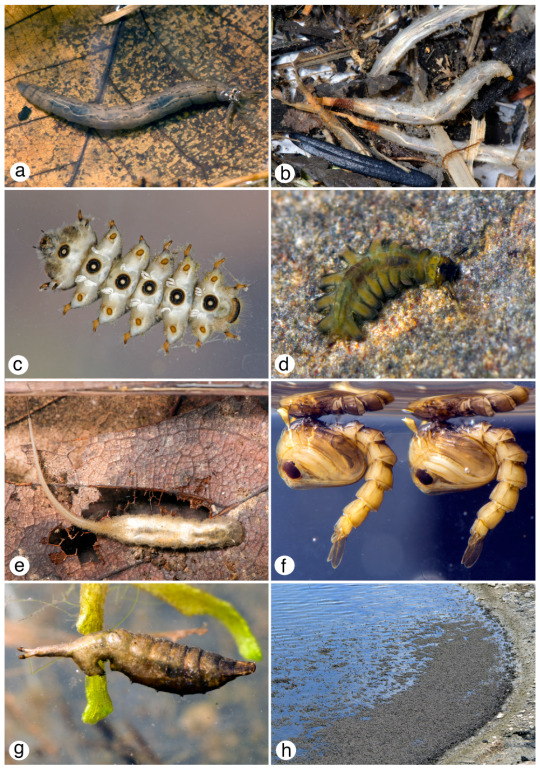
(Image ID: a collage of aquatic larvae of multiple species in the order Diptera (true flies. They vary from slug-like to having multiple distinct body segments with legs, to looking like maggots with long tails. End ID. Source)
Mayflies (order Ephemeroptera) are among the oldest lineages of winged insects, bearing traits that they first flying insect also had. Juvenile mayflies are technically not larvae, but nymphs. The difference between a larva and a nymph is that nymphs look much more like the adult stage than larvae do. Mayfly nymphs lack the wings of adults, but have external gills growing from the sides of their abdomens. Mayfly nymphs can be identified by three appendages called cerci that emerge from the back of the abdomen. They are bottom-dwellers that typically live under rocks and other objects or amid plants. Most are herbivores, feeding mainly on algae. Months to years after hatching (species dependent), mayflies will float to the surface and go through a molt to a stage called the subimago. Uniquely among insects, mayflies go through two final winged molts. The first is to a not sexually mature stage called the subimago, then they quickly molt again into a fully mature imago stage. These molts happen in sync, resulting in hundreds to thousands of mayflies appearing all at once and swarming together to mate. Famously, adult mayflies exist only to mate and die. Their digestive systems are non-functional and few species last past a few days.

(Image: a mayfly nymph on a rock. It is a yellow bug with no wings, a long abdomen, and thick, grasping legs. Three long, hairy cerci emerge from the back. Along the side of the abdomen are multiple pairs of white, feathery gills. End ID)
Stoneflies (order Plecoptera) also have nymphs and can be quite difficult to tell apart from mayfly nymphs if you don't know what to look for. One of the biggest differences is that their gills are located by the base of the legs rather than along the abdomen. Like mayflies, stoneflies are some of the most primitive winged insects, but mayflies are Paleopterans (the earliest wings insects) while stoneflies and most other winged insects are Neopterans. The main difference is that Neopterans can flex their wings over their abdomens while Paleopterans cannot, and must hold their wings either out to the side or up in the air. Like with Mayflies, many adult stoneflies have nonfunctional digestive systems and exist only to mate and die.

(Image: a stonefly larva. It looks similar to a mayfly larva, but has a shorter abdomen, gills along the base of the legs, and only two cerci. End ID)
Caddisflies (order tricoptera) are the builders of the aquatic insect world. These larvae (most species anyway) can produce silk from glands near their mouths. These are used to make a variety of structures made from silk and various other materials including sand, silt, plant parts, shells, rock, and so on. Different species will seek out specific materials for their structures. There are a few types of structures, the most common of which is a tubular case that is open at both ends. The larva can carry the case with it as it crawls around and can retreat into the case for protection. The larva can draw water into one end of the case and out the other, allowing oxygenated water to flow over the gills. By moving around in the case, the larva can draw in more water. This allows the larvae to survive in water that is too oxygen-poor for other larvae. Other species build different structures including turtle-shell like domes or stationary retreats. My favorite structures are nets built with an open end into current. The current naturally brings detritus and micro-invertebrates into the net, where the larva can eat them. Caddisflies also pupate into pupa that have mandibles to cut their way out of their cases and swimming legs. Once developed, the pupae swim to the surface and molt into their adult forms. This molting is synchronized to ensure the adults emerge in swarms and can easily find mates.
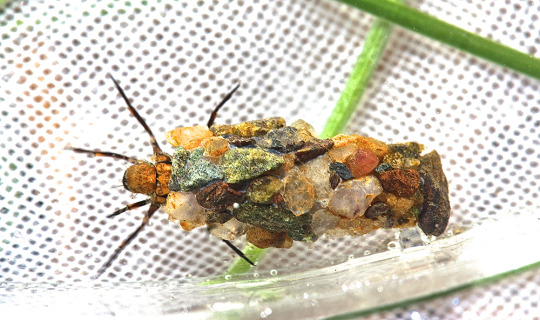
(Image ID: a caddisfly larva in its case. The case is a tube composed of pebbles of different colors stuck together with silk. The head and legs of the larva are merging from the front of the case. End ID)
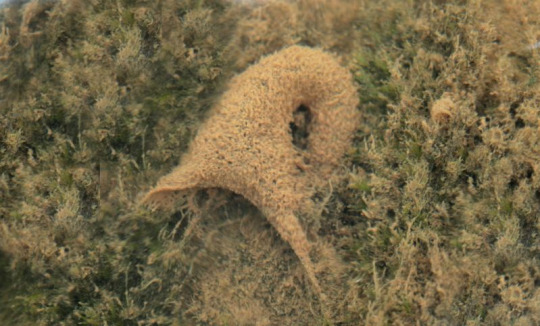
(Image: a caddisfly net. It is a structure made of silk shaped like a tube that is wide at one end and tapers toward the other. It is curved so both ends face the same way. End ID)
The order Megaloptera consists of alderflies, dobsonflies, and fishflies. All three have aquatic larvae, but their eggs are laid on land. Most species lad their eggs on plants overhanging the water so the larvae fall in once hatched, though a few lay eggs near the water's edge, forcing the larvae to crawl in. Meglaoptera have the least amount of differences between larva and adult of all holometabolous (pupa-forming) insects. The largest differences between the larvae and adults is the larvae lack wings and some species have leg-like prolegs. All species are carnivorous as larvae and feed on other invertebrates.
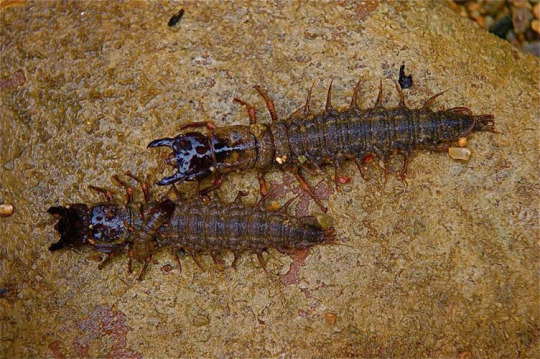
The adults don't look any less creepy
(Image: two hellgrammites, the larval form of a dobsonfly. It looks somewhat like a centipede with three pairs of limbs and a long abdomen with multiple pairs of leg-like prolegs. The head has no visible antennae, but does have a pair of powerful pincers. End ID)
Order Odonata consists of dragonflies and damselflies. These are powerful predators both as nymphs and adults. As nymphs, the juveniles are shorter and stockier than the adults, with no wings. The nymphs (or naiads) breathe through gills. In damselflies, these gills can be external, but dragonfly nymphs have their gills located in the anus. Damselflies can swim by undulating their gills, but dragonfly nymphs are restricted to crawling. The nymphs are voracious predators that will feed on anything they can catch. Most of their diet consists of invertebrates, but they will also attack small fish, tadpoles, and even salamanders.
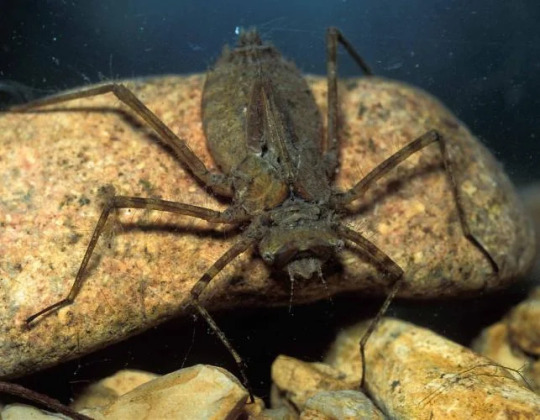
(Image ID: a dragonfly larva on a rock. Its head is similar to that of the adults, but the abdomen is much shorter and broader and the legs are longer. It has no wings and is brown all over. End ID)
The groups of insects I covered today (plus the stoneflies) all have exclusively or near-exclusively have aquatic larvae while the adults are terrestrial. In other groups, aquatic larvae may be present in some species while others have terrestrial larvae. For example, a great many members of the order Diptera (true flies) have aquatic larvae including all mosquitos, while other members of the order have fully terrestrial larvae. In addition there are species of beetle (order Coleoptera), moth (order Lepidoptera), lacewing (order Neuroptera), and scorpionflies (order Mecoptera) that have aquatic larvae and some species of the true bugs (order Hemiptera) have aquatic larvae and aquatic adults, including water skaters, water scorpions, and giant water bugs. Aquatic insects are so prevalent that it is rare to find any lasting body of water that doesn't host some aquatic larvae or adults. Even incredibly stagnant and filthy water can host aquatic insect larvae, as shown by the notorious rat-tailed maggots, who love stagnant water and breathe through snorkels. Many species require very specific conditions and there are species of insect who exclusively grow their larvae in specific streams or lakes. Because of this, conservation of these bodies of water is vital to their survival and pollution, damming, and other factors can destroy whole species.
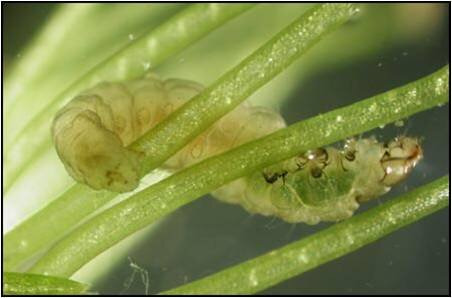
(Image: an aquatic moth larva. It looks very similar to a green land caterpillar, with none of the fancy elements many land species have. It is translucent and wrapped around some aquatic plant stems. End ID)
#wet beast wednesday#insects#insect larvae#aquatic insect larvae#larva#pupa#mayfly#stonefly#caddisfly#dobsonfly#hellgrammite#dragonfly#damselfly#freshwater ecology#ecology#biology#zoology#invertebrate#invertebrates#animal facts#informative#bug#bugs
31 notes
·
View notes
Text

speculative biology: terrestrial caddisfly larvae (yes I know about bagworms, but I was inspired by this art) that live in your junk drawers and accumulate what they can find. this one has made its case out of bits of yarn it smooshed together into pompoms, plus various other baubles and notions.
#bug#bugs#bugblr#insect#insects#insect art#bug art#entomology#invertebrates#arthropods#insecta#id in alt#caddisfly#caddisfly larvae#caddisflies#Trichoptera#sedge flies#rail flies
377 notes
·
View notes
Text

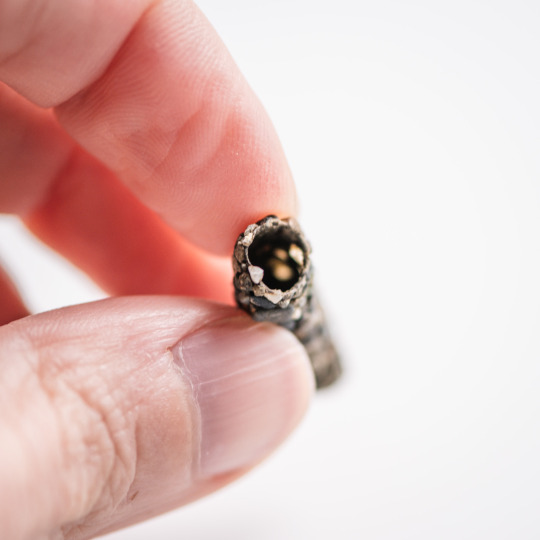
Caddisfly larval case made of silk and sand
#artists on tumblr#original photographers#original photography#orofeaiel#nikon#pnw#nature#washington#pacific northwest#hiking#caddisfly#larval case#caddisflies#insects#entomology#macro photography#small treasures#beach finds
24 notes
·
View notes
Text
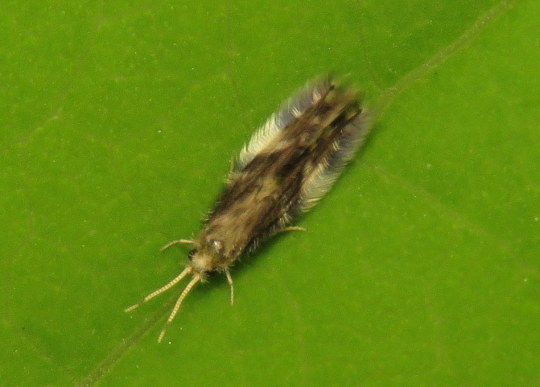
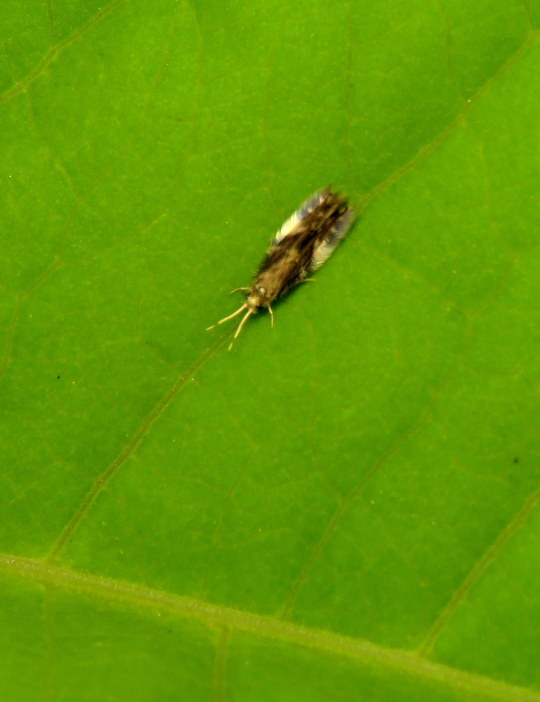
Bug of the Day
Ok, here is something tiny and fuzzy for today's Bug of the Day. This is a microcaddisfly - if you are familiar with caddisflies, they are in the same order but so so much smaller. This one is just a few millimeters long. If you are not familiar with caddisflies, then, well, this is just smol and fuzzy :-). I found it on a Japanese knotweed leaf (zoomed out photo to try to show you the scale).
#microcaddisfly#Hydroptilidae#Trichoptera#caddisfly#tiny#smol#fuzz#fuzzy#bug of the day#BotD#Japanese knotweed#knotweed
54 notes
·
View notes
Text
A particular Ichneumonid that I find fascinating is Agriotypus (Agriotypinae). It has a fascinating life cycle. They are parasitoids of Trichoptera pupae and pre-pupae. To quote the book - Ichneumonid Wasps (Hymenoptera: Ichneumonidae): their Classification and Biology by Gavin Broad, Mark R. Shaw & Michael G. Fitton:
"Females descend beneath the surface of the water and when submerged they are covered by a film of air, and the antennae and wings are laid back over the body. They periodically come up to the surface to replenish their air supply. Under water, they crawl about on stones and water plants and can adjust their buoyancy by scraping off some of the air film with the hind legs. They can take flight directly from the water surface (Clausen, 1931) or they can skim along it like pond skaters but with the wings providing propulsion."
In this case, in my drawing, the antennae are not laid back over the body, but I have seen pictures of Agriotypus submerged in water with the antennae pointing upward.

#hymenoptera#insect#wasp#wasps#entomology#apocrita#cartoon#comic#parasitica#Ichneumonidae#Agriotypinae#Agriotypus#Trichoptera#Caddisfly
103 notes
·
View notes
Text

The Ace of Shells delves into the realm of pure emotion, intuition, and the overflowing of feelings. It embodies themes of emotional purity, spiritual awakening, and the boundless capacity of the heart. Many species of larval caddisflies will create protective cases made of sand, stones, mollusk shells, or plant materials held together by silk. Within these cases, they live submerged in water, exemplifying the deep connection to their aquatic environment and symbolizing the idea of being immersed in the rich waters of emotions.
This card encourages us to open our hearts to new beginnings, to embrace our emotional depths, and to allow the purest expressions of love and intuition to flow freely. Like a chalice overflowing with water, it is a reminder that our hearts have the capacity to brim with compassion and empathy for ourselves and others.
The young caddisfly’s life underwater, within their protective case, can be seen as a metaphor for the inner journey of self-discovery and the exploration of our emotional depths, as well as a representation of finding solace and spiritual connection within ourselves - even when navigating the unpredictable waters of life. The case represents the emotional shelter within us, where we navigate the ebb and flow of our inner seas.
The Ace of Shells serves as a reminder to open our hearts to new beginnings, embracing our emotional depths with vulnerability and authenticity. It's a call to let our emotions flow freely. Overall, this card encourages us to embrace the vast ocean of our emotions, fostering empathy and love. It reminds us to cherish our emotional core and the deep currents of the heart. We can find strength and sanctuary in the uncharted waters of our inner selves.
Prints available on Redbubble and Inprnt
| Instagram |
#artists on tumblr#illustration#insects#tara jillian art#nature#bugs#redbubbleartist#bug tarot#tarot cards#tarot art#big bug gospel#invertebrates#insect art#entomology#invertblr#bugblr#tarotblr#caddisfly
21 notes
·
View notes
Text

Egg mass of a Caddis Fly (Glyphotaelius pellucidus) - Christchurch Park, Ipswich, East Suffolk - England - 5 Oct. 2014
11 notes
·
View notes
Text
@hairynoodlelegs submitted: Spring is here and the bugs are out!!!!! i forgot the english name of these dudes but i love them and their little homemade houses so much
This fella is a caddisfly larva! And what an excellent home they've created :)
265 notes
·
View notes
Text
This is a long shot but if someone can save me a few hours worth of research I'd be super grateful
I am a field technician doing stream monitoring and my local county department is developing a more detailed assessment method using family-level pollution tolerances rather than the more commonly used method of sorting specimens into either Philopotamidae vs. Hydropsychidae. Through my research I've found that tolerance varies between members of the same family, and it is useful to also be aware of genus-level tolerances. Unfortunately, I haven't been able to find a good reference for many genera (except for macroinvertebrates.org, love that site) I also don't have access to paywalled research papers and have been stuck with looking through old government reports and open-source journals. Is anyone willing to share a good paper/report/website with me that includes any information available for Trichoptera (and any other macroinvertebrate order) genera-level tolerance values?
(I tried posting on reddit but all the relevant invert forums are dead)
#wrenfea.exe#invertebrates#macroinvertebrates#trichoptera#caddisfly#biomonitoring#stream science#stream ecology#freshwater ecology#bugs#insects#larvae#larva#fishing#btw if anyone is interested in aquatic insects please look at macroinvertebrates.org its amazing#biology#marine science
9 notes
·
View notes
Text

Caddisfly, Limnephilus sp Canon 400D EF 100 2.8 f/5/1/320 iso: 800 Celakovice-Jirina, Czech Republic 9/23/2010
#Caddisfly#Limnephilus#case-maker#insect#Invertebrate#Wetlands#macro#invertebrates#insects#insectphotography#macrophotography#canon
10 notes
·
View notes
Text
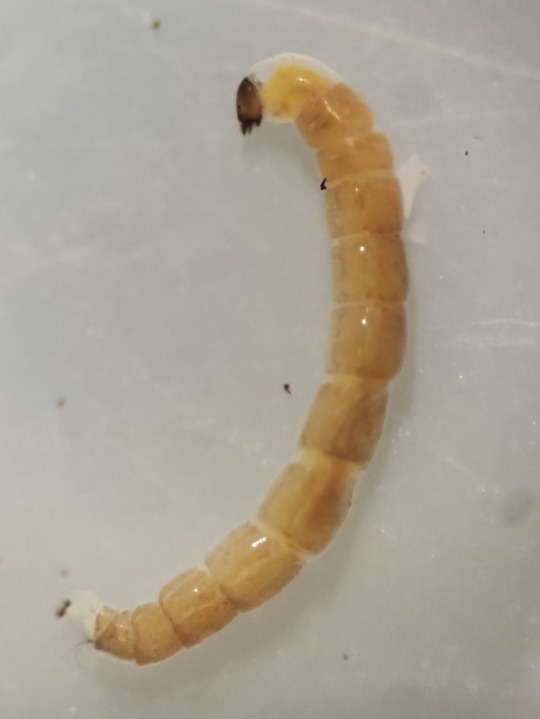

Chironomidae (midge) larva and Trichoptera (caddisfly) larva
4 notes
·
View notes
